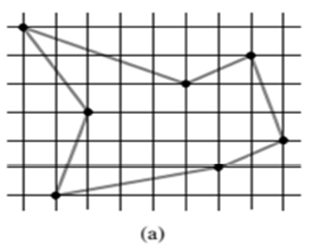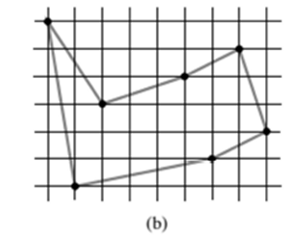
Concept explainers
(a)
To describe a dynamic-
(a)
Explanation of Solution
Given Information:
The shortest closed tour of the graph with length approximately is 24.89. The directed acyclic graph is shown below-

Explanation:
The dynamic-approach used to find the longest length simple path consider the graph G and vertices as V. The longest simple path must go through some edge of weight s or t . The algorithms to compute the longest weight path is
The base condition for the algorithm is
The algorithm to compute longest simple path in a directed acyclic graph is given below-
LONG-PATH(G,u,s,t,len)
If
set
return ( len,u )
else if
Return (len,u).
else
for each adjacent vertex
Check the distance after adding new vertex i.
if
end if.
end for.
end if.
return ( len,u ).
end.
In above algorithm, loop of for is used to determine the longest path and the longest path visit all vertex by checking all adjacent vertex.
The time taken by the algorithm is depends upon the number of vertex visited and the number of edges in the longest simple path. Suppose V represent the number of vertex used in the computing the longest simple path and E represent the number of edges then total running time of the algorithm is equals to
(b)
To describe a dynamic-programming approach for finding longest simple path in directed acyclic graph and also give the running time of the algorithm.
(b)
Explanation of Solution
Given Information:
The shortest closed tour of the graph with length approximately is 25.58. The directed acyclic graph is shown below-

Explanation:
The longest simple path must go through some edge of weight s . The base condition for the algorithm is
The algorithm to compute longest simple path in a directed acyclic graph is given below-
LONG-PATH(G,u,s,t,len)
If
set
return ( len,u )
else if
Return (len,u).
else
for each adjacent vertex
Check the distance after adding new vertex i.
if
end if.
end for.
end if.
return ( len,u ).
end.
The time taken by the algorithm is depends upon the number of vertex visited and the number of edges in the longest simple path. Suppose V represent the number of vertex used in the computing the longest simple path and E represent the number of edges then total running time of the algorithm is equals to
The above algorithm taken consideration of the nodes and generates the output according to the number of nodes in the graph so the longest length is computed by
Want to see more full solutions like this?
Chapter 15 Solutions
Introduction To Algorithms, Third Edition (international Edition)
- what type of internet connection should be avoided on mobile devices?arrow_forwardI need help creating the network diagram and then revising it for the modified activity times.arrow_forwardActivity No. Activity Time (weeks) Immediate Predecessors 1 Requirements collection 3 2 Requirements structuring 4 1 3 Process analysis 3 2 4 Data analysis 3 2 5 Logical design 50 3,4 6 Physical design 5 5 7 Implementation 6 6 c. Using the information from part b, prepare a network diagram. Identify the critical path.arrow_forward
- Given the following Extended-BNF grammar of the basic mathematical expressions: Show the derivation steps for the expression: ( 2 + 3 ) * 6 – 20 / ( 3 + 1 ) Draw the parsing tree of this expression. SEE IMAGEarrow_forwardWhentheuserenters!!,themostrecentcommandinthehistoryisexecuted.In the example above, if the user entered the command: Osh> !! The ‘ls -l’ command should be executed and echoed on user’s screen. The command should also be placed in the history buffer as the next command. Whentheuserentersasingle!followedbyanintegerN,theNthcommandin the history is executed. In the example above, if the user entered the command: Osh> ! 3 The ‘ps’ command should be executed and echoed on the user’s screen. The command should also be placed in the history buffer as the next command. Error handling: The program should also manage basic error handling. For example, if there are no commands in the history, entering !! should result in a message “No commands in history.” Also, if there is no command corresponding to the number entered with the single !, the program should output "No such command in history."arrow_forwardActivity No. Activity Time (weeks) Immediate Predecessors 1 Requirements collection 3 2 Requirements structuring 4 1 3 Process analysis 3 2 4 Data analysis 3 2 5 Logical design 50 3,4 6 Physical design 5 5 7 Implementation 6 6 c. Using the information from part b, prepare a network diagram. Identify the critical path.arrow_forward
- 2. UNIX Shell and History Feature [20 points] This question consists of designing a C program to serve as a shell interface that accepts user commands and then executes each command in a separate process. A shell interface gives the user a prompt, after which the next command is entered. The example below illustrates the prompt osh> and the user's next command: cat prog.c. The UNIX/Linux cat command displays the contents of the file prog.c on the terminal using the UNIX/Linux cat command and your program needs to do the same. osh> cat prog.c The above can be achieved by running your shell interface as a parent process. Every time a command is entered, you create a child process by using fork(), which then executes the user's command using one of the system calls in the exec() family (as described in Chapter 3). A C program that provides the general operations of a command-line shell can be seen below. #include #include #define MAX LINE 80 /* The maximum length command */ { int…arrow_forwardQuestion#2: Design and implement a Java program using Abstract Factory and Singleton design patterns. The program displays date and time in one of the following two formats: Format 1: Date: MM/DD/YYYY Time: HH:MM:SS Format 2: Date: DD-MM-YYYY Time: SS,MM,HH The following is how the program works. In the beginning, the program asks the user what display format that she wants. Then the program continuously asks the user to give one of the following commands, and performs the corresponding task. Note that the program gets the current date and time from the system clock (use the appropriate Java date and time operations for this). 'd' display current date 't': display current time 'q': quit the program. • In the program, there should be 2 product hierarchies: "DateObject” and “TimeObject”. Each hierarchy should have format and format2 described above. • Implement the factories as singletons. • Run your code and attach screenshots of the results. • Draw a UML class diagram for the program.arrow_forward#include <linux/module.h> #include <linux/kernel.h> // part 2 #include <linux/sched.h> // part 2 extra #include <linux/hash.h> #include <linux/gcd.h> #include <asm/param.h> #include <linux/jiffies.h> void print_init_PCB(void) { printk(KERN_INFO "init_task pid:%d\n", init_task.pid); printk(KERN_INFO "init_task state:%lu\n", init_task.state); printk(KERN_INFO "init_task flags:%d\n", init_task.flags); printk(KERN_INFO "init_task runtime priority:%d\n", init_task.rt_priority); printk(KERN_INFO "init_task process policy:%d\n", init_task.policy); printk(KERN_INFO "init_task task group id:%d\n", init_task.tgid); } /* This function is called when the module is loaded. */ int simple_init(void) { printk(KERN_INFO "Loading Module\n"); print_init_PCB(); printk(KERN_INFO "Golden Ration Prime = %lu\n", GOLDEN_RATIO_PRIME); printk(KERN_INFO "HZ = %d\n", HZ); printk(KERN_INFO "enter jiffies = %lu\n", jiffies); return 0; } /* This function is called when the…arrow_forward
 Operations Research : Applications and AlgorithmsComputer ScienceISBN:9780534380588Author:Wayne L. WinstonPublisher:Brooks Cole
Operations Research : Applications and AlgorithmsComputer ScienceISBN:9780534380588Author:Wayne L. WinstonPublisher:Brooks Cole Fundamentals of Information SystemsComputer ScienceISBN:9781305082168Author:Ralph Stair, George ReynoldsPublisher:Cengage Learning
Fundamentals of Information SystemsComputer ScienceISBN:9781305082168Author:Ralph Stair, George ReynoldsPublisher:Cengage Learning C++ Programming: From Problem Analysis to Program...Computer ScienceISBN:9781337102087Author:D. S. MalikPublisher:Cengage Learning
C++ Programming: From Problem Analysis to Program...Computer ScienceISBN:9781337102087Author:D. S. MalikPublisher:Cengage Learning Principles of Information Systems (MindTap Course...Computer ScienceISBN:9781285867168Author:Ralph Stair, George ReynoldsPublisher:Cengage LearningNp Ms Office 365/Excel 2016 I NtermedComputer ScienceISBN:9781337508841Author:CareyPublisher:Cengage
Principles of Information Systems (MindTap Course...Computer ScienceISBN:9781285867168Author:Ralph Stair, George ReynoldsPublisher:Cengage LearningNp Ms Office 365/Excel 2016 I NtermedComputer ScienceISBN:9781337508841Author:CareyPublisher:Cengage





